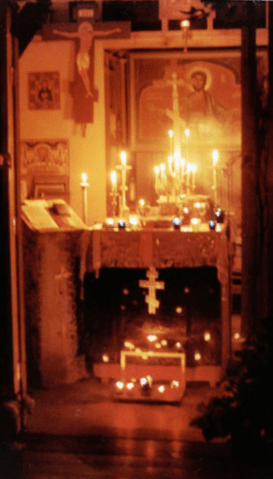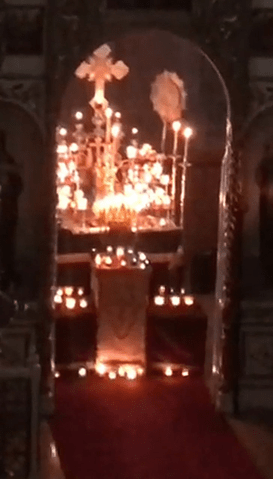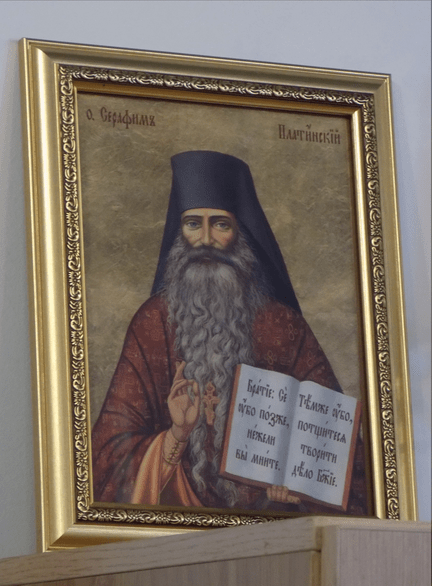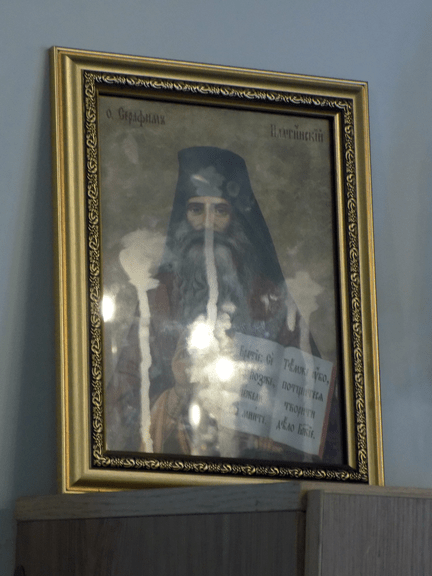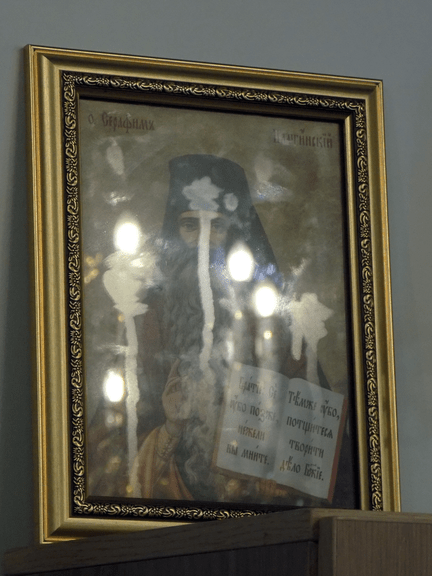Fact 11
Myrrh streaming of the iconographic image of Hieromonk Seraphim (Rose) Platinsky: fact and description April 29th, 2021
On April 29, 2021, from 00:00, there has been a Vigil service of the Great Thursday of Holy Week, at the Church of the Holy Trinity, the city of Novotroitsk, the Orsk diocese, the Orenburg region/metropolitanate.
The service was performed at night according to the liturgical rite, included as a part of the Matins. We adopted this rite from the monastery of St. Herman of Alaska, in Platinum, from the lifetime of Hieromonk Seraphim of Platinum (Rose) according to eyewitnesses. Apparently, Hieromonk Seraphim and Abbot Herman have taken this custom from the traditions of southern Russia, according to Maria Mansur, the spiritual daughter of Fr. Seraphim.
It’s done as follows:
During the Matins service, after the ninth ode of the canon of the Great Thursday, before the singing of “Thy Bridal Chamber ...”, the light is extinguished in the temple, including all the candles, and the singers come to the center in front of the icon. They then begin to sing svetilen for the first time in complete darkness. On “Glory…” the veil is opened, and the svetilen is sung for a second time; ... on "Now and ever ..." the Royal Doors are opened, and the svetilen is sung for a third time, as indicated in the charter of worship.
The peculiarity of this ecclesiastical rite is that the altar of the temple and, in particular, the Altar Table, are preliminarily decorated with lamps. Often all the icon lamps available in the church are being used. Those are placed on the Altar Table, near the Altar Table ... External candlesticks are placed around the Altar Table ..., perhaps on coasters and additional benches, icon lamps are also arranged in front of the Altar Table.
And when the veil opens, followed by Royal Doors, from the darkness of the temple we see with our own eyes the "Thy bridal chamber" - the image of the Kingdom of Heaven. And we realize with sadness that "I have no wedding garment that I may enter there". Then all these image-relationships are heard and seen in a special way! With a special feeling we then sing and feel: “... Make the robe of my sole to shine, O Giver of Light, and save me!”
It is very beautiful and clear.
Having learned about this tradition, established during the life of Fr. Seraphim at the Monastery of Platina, we wanted to set up the same tradition in our church out of love and in honor of him. This is the second year that we have performed this liturgical rite. A similar tradition also exists at the church of “All Russian Saints” in Burlingame (California) for the same reason. Namely, after the death of Fr. Seraphim it was transferred from Platina by his spiritual children who had then attended that church.
Below are the pictures of the altar of St. Herman of Alaska monastery taken at the lifetime of Fr. Seraphim (left) and that of the "Church of All Russian Saints" at our time (Burlingame, CA) (right) during the specified rite of the Great Thursday.
Apparently, it was during the service of Great Thursday Matins on April 29, 2021, in the Church of the Holy Trinity in the city of Novotroitsk, the Orsk diocese, the Orenburg Metropolitanate, the myrrh-streaming of the iconographic image of Hieromonk Seraphim Platinsky took place. The image was purchased in the monastery shop "in Platina" (Platina, CA) in 2019, and upon arrival to our church, framed with glass and stored in the altar of our church. The myrrh-streaming was only noticed in the morning, after the service of the Divine Liturgy of the Great Thursday, which we celebrated that day at 8am.
During the liturgical rite described above at Vigil service, there was one extraordinary event. The discovery of myrrh made us recall and consider it a possible indication of the actual time of myrrh-streaming event.
Using this link you can see a photograph of the altar and the Altar Table decorated with lamps for celebration of the described rite of Great Thursday Matins. That’s when Hieromonk Seraphim’s visit took place, marked by the myrrh-streaming of his image.
The pattern of myrrh-streaming consists of three large streaks (from the place of origin to the lower edge of the image) and one small one (on the forehead and ramen). There are also several separate smaller spots of various sizes, shaped round and oval. Spots and streaks (which initiate from spots as well) are several centimeters in size, oily, occur on the outside of the glass, odorless. Those are not easy to erase. They resemble the substance of some vegetable oil that has begun to solidify, as if it were several years old.
An oily trace remains on the fingers if the stain is touched, but upon erasing with a viscose disposable napkin it retains the lint from the napkin and is not immediately removed from the glass. It can only be erased with a few repeated efforts and pressing. In fact, the whole glass surface is covered with a light layer of the same substance.
Spots (places of myrrh origin) are irregularly shaped, but have clearly defined edges.
Everything described above is clearly visible in the photographs presented.
The oily nature of the spots and streaks is best visible on the large photo. At the top right, slightly above and to the right are the reflections of a pair of altar chandeliers, an area affected when studying the phenomenon in question. That allowed partial understanding and description of the physical nature and features of this myrrh-streaming.
The left drip and/or a nearby small spot is partially smeared by the “curious” hand of the altar servers, although initially it was of very well defined shape, just like other source spots. However, even now the trace can be clearly seen. Down the drip of the middle spot - smearing from veneration by believers.
This fact of May 21, 2021, was inspected and witnessed by Bishop Irenei of Orsk and Gaisky in the presence of the deans of two deaneries of the Orsk diocese: Archpriest Alexander Kutsov, Archpriest Sergius Kvasha; rector of the temple, Priest Alexander Trushin and parishioners. Following inspection, a memorial service has been served to honor Hieromonk Seraphim Platinsky.
The results of all findings are documented and stored in the diocesan archive
Concluding remarks
This description of the manifestations of divine grace through the prayers of Hieromonk Seraphim Platinsky is attached to a number of the facts described previously in 2020. It is a continuation of his glorious deeds and miracles in order to promptly consider the issue of canonization and with the hope of legally glorifying him among people on earth, likewise God, we believe, humbly shows us his glory in Heaven.
In light of the described event and as a result of studying the facts of the manifestation of divine grace through the prayers of Hieromonk Seraphim, we have noted two cases of myrrh-streaming: the first - on October 3, 2019, followed by the continuous myrrh-streaming and witnessing on October 15, 2019, described in the previous study of 2020: “Posthumous manifestations of divine grace through the prayers of Hieromonk Seraphim of Platinsky” (Fact 5); and the second on April 29, 2021, described on the pages above.
The reoccurence of this type of event (myrrh-streaming) allows us to notice a certain nature of its manifestation.
Events are clearly notable for their apparent speed and relevance to the place and time of veneration of Fr. Seraphim. The response is not unlike of that of the living human being.
The end and Glory to our God!
